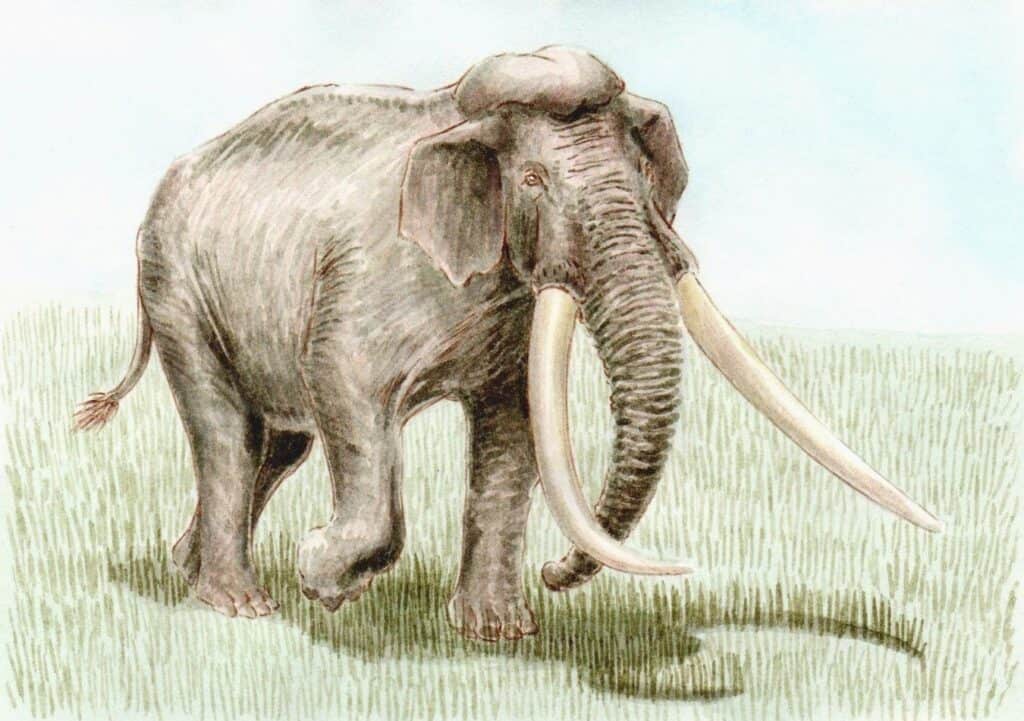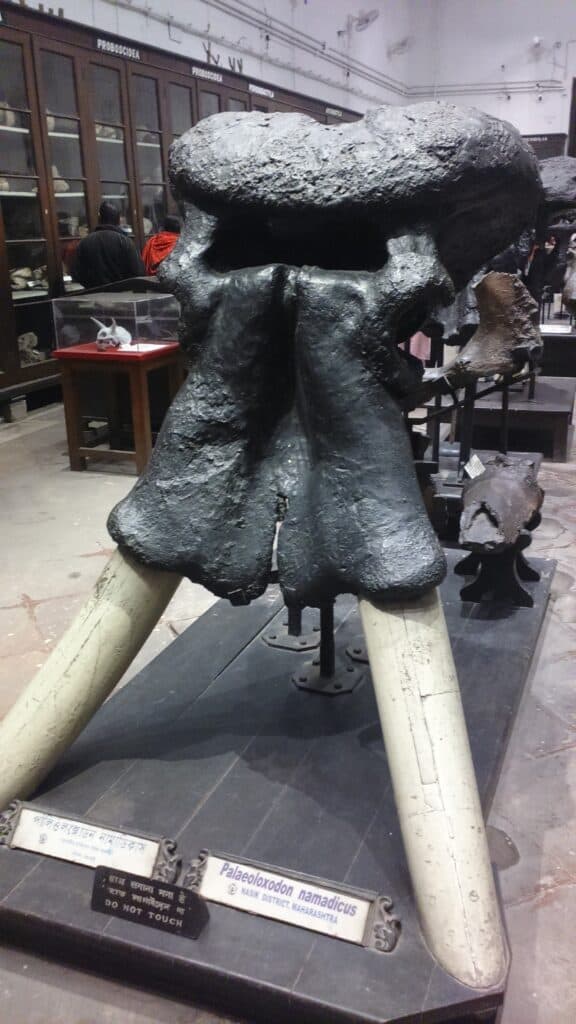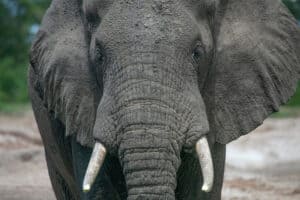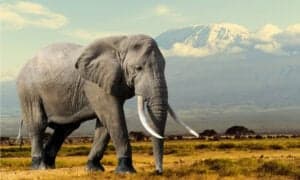Present-day elephants are the biggest land animals. The African bush elephant (Loxodonta africana) weighs over 10 tons and is up to 13 feet tall. Their Asian relatives, Elephas maximus, rank next on the list of the planet’s heaviest creatures, with a 10-ton mass and eight-foot height. However, like all animals, these massive beasts are dwarfs compared to the huge elephants that lived in the prehistoric past.
In the “not-so-distant” past, elephants were much bigger than they are today. One of the giants of the geologic record is the Palaeloxodon namadicus. Beyond the noticeable size difference, this massive elephant looked similar to modern elephants and other land mammoths. However, it had several distinct features that made it remarkably different from current-day elephants.
What Did Palaeoloxodon namadicus Look Like?

Palaeoloxodon namadicus.
©Baperookamo, CC BY-SA 4.0 <https://creativecommons.org/licenses/by-sa/4.0>, via Wikimedia Commons – License
The lack of complete fossils has made it impossible to tell the exact size of this huge elephant. In 2015, scientists conducted extensive research to determine the size of this elephant based on fragmentary leg bones. The result of this study led to the conclusion that P. namadicus was probably the largest land mammal ever walking the planet.
The minimum height estimate for this elephant is about 14.8 feet. However, some studies argue that a shoulder height of up to 17.1 feet is more accurate. Estimating the weight has even been more difficult since there aren’t a lot of bone remains to begin with. However, experts think the Palaeoloxodon namadicus may have weighed around 22 tonnes.
Many physical attributes of this prehistoric elephant differ from those of its modern relatives. To start with, this elephant’s tusks lacked the curvature of current elephant tusks. It has been nicknamed the Asian straight-tusked elephant because of this.
Palaeoloxodon namadicus is not the only ancient elephant with a straight tusk. In fact, many scientists still consider P. namadicus as a subspecies of the European straight-tusked elephant because of how similar their tusks were.
As expected of such a huge elephant, Palaeoloxodon had a huge skull. Hugh Falconer, a geologist, likened its head to a “caricature of an elephant’s head in a periwig.” The skull also featured a distinctive parieto-occipital crest which looked like a headband across the elephant’s large cranium. Studies to examine the nature of this crest suggest that it developed as the animal grew older. The crest was less-pronounced in juvenile Palaeoloxodon but grew larger as the specie became older. The skull crest was more developed, sturdy, and prominent in mature elephants.
Name, Species, and Classification
This huge elephant belongs to the family Elephantidae, the same family as modern-day elephants and the now-extinct mammoths. The closest living relative of this species is the African elephant.
Palaeoloxodon namadicus was once considered a subspecies of the Palaeoloxodon antiquus species, the European straight-tusked elephant. However, paleontologists have noted differences between the sizes of their skull crests.
Of these vast elephant species, P. namadicus had the most prominent crest. However, this differentiation still remains largely controversial. Many experts suspect these discovered remains may belong to the same species.
What Did the Prehistoric Elephant Feed On?

Palaeoloxodon namadicus fossilized remains.
©Royroydeb, CC BY-SA 4.0 <https://creativecommons.org/licenses/by-sa/4.0>, via Wikimedia Commons – License
So what’s a giant elephant’s diet like? Scientists believe Palaeoloxodon namadicus was an herbivorous grazer. Scientists measured the elemental isotope ratio and studied their teeth morphology to determine the nature of this elephant’s diet. This study confirms the theory that this elephant was a grazer (i.e., they fed on low-growing plants).
This feeding habit is unlike modern elephants in the living Elephas genus and the extinct Stegodon genus. The members of these two genera were predominantly browsers, meaning they fed on foliage on trees rather than grass. Palaeoloxodon namadicus, on the other hand, was an active grazer.
Like modern elephants, Palaeoloxodon namadicus probably formed small herds. They probably migrated from one location to another in search of vegetation to feed on. Some studies also suggest that they probably had a variable diet that was dependent on the prevailing environmental conditions at the time.
Where Did This Huge Elephant Live?
As the name suggests, the Asian straight-tusked elephant is native to Asia. The species primarily lived on the Indian subcontinent during the Mid and Late Pleistocene. The animal lived in the temperate forested areas that supported its grazing feeding habits.
Palaeoloxodon namadicus remains have also been found on Sulawesi Island in Indonesia. Other fragmented fossil remains of the species have been found in other parts of Asia, including China. However, the validity of most of these fossils has been disputed as they may have belonged to a different species of elephants.
It is important to note that the Palaeoloxodon genus evolved originally in Africa before members of this genus spread into Eurasia. The genus was dominant in Africa for most of the Pliocene and Early Pleistocene epochs but eventually spread to other continents.
Threats and Extinction
Palaeoloxodon namadicus was one of the four massive animals native to India that went extinct during the Pleistocene. Others include the Stegodon namadicus (a relative of the elephants), the giant horse (Equus namadicus), and a massive hippopotamus from the genus Hexaprotodon.
The extinction of the ancient elephant could have been caused by climatic factors. Experts think these animals probably disappeared due to significant climatic changes at the end of the Pleistocene Epoch. Their disappearance coincides with the last ice age, which ended about 25,000 years ago. The climate grew significantly cooler towards the end of the period, and the forests began to shrink. This had a massive negative impact on the species. The forest contractions meant the grazers’ food was gradually reducing too. Lack of food eventually made the prehistoric elephant go extinct.
Considering the size of this mammal, it is unlikely that any of the carnivores that lived in Asia at the time was a major threat to it. We do know that the later years of their existence overlapped significantly with humans. Since prehistoric men hunted many of the other megafauna (including the related Palaeoloxodon antiquus in Europe), there’s a good chance that the Asian straight-tusked elephant also suffered the same fate.
Other indirect human activities would have also threatened the animal’s existence. Even though it is not sure if the early men hunted this giant elephant for food, they probably used their tusks and bones to carve out tools. There was more resource demand as the human population developed and grew more prominent. This gave rise to deforestation and a lot of forest fires. These actions damaged the natural habitat of Palaeloxodon and forced them to retreat into the receding forests.
Up Next
- African Elephant vs Asian Elephant: 5 Key Differences
- What Is The World’s Largest Elephant?
- What Do Elephants Eat? Their Diet Explained
The photo featured at the top of this post is © Baperookamo, CC BY-SA 4.0
Sources
- Wikipedia, Available here: https://en.wikipedia.org/wiki/Palaeoloxodon_namadicus
- Eurekalert, Available here: https://www.eurekalert.org/news-releases/920433
- Science Direct, Available here: https://www.sciencedirect.com/science/article/abs/pii/S0031018206004032?via%3Dihub
Thank you for reading! Have some feedback for us? Contact the AZ Animals editorial team.







